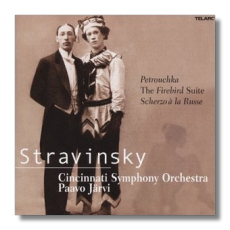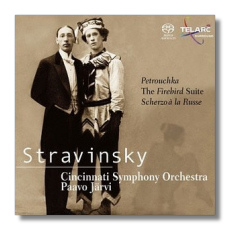
The Internet's Premier Classical Music Source
Related Links
- Stravinsky Reviews
- Latest Reviews
- More Reviews
-
By Composer
-
Collections
DVD & Blu-ray
Books
Concert Reviews
Articles/Interviews
Software
Audio
Search Amazon
Recommended Links
Site News
 CD Review
CD Review
Igor Stravinsky

- Pétrouchka (1947 version)
- Scherzo à la Russe
- Firebird: Suite (1919 version)
Cincinnati Symphony Orchestra/Paavo Järvi
Telarc CD-80587 DDD 59:42
Also released on Hybrid Multichannel SACD SACD-60587
Amazon
- UK
- Germany
- Canada
- France
- Japan
- ArkivMusic
- CD Universe
Paavo Järvi – born in Estonia like his father, conductor Neeme Järvi – has been music director of the Cincinnati Symphony Orchestra since the fall of 2001. Although he studied with Leonard Bernstein, his interpretations suggest the old saying, "like father, like son." (Time will tell if the younger Järvi has his father's voracious appetite for repertoire, however.)
The Cincinnatians should be proud of their conductor, and of this recording in particular: it presents the city's musical life in a positive light. The orchestra is first-class; at least on CD, it yields little to the other major American orchestras. Järvi, in my few experiences with him, is a conductor who approaches familiar repertoire with thoughtfulness. There is an unusual precision to the music-making on this CD. In Pétrouchka, the scene between the Blackamoor and the Ballerina comes off particularly well because of Järvi's discipline in lining up the characters' clashing melodies. The conductor has a good ear for maintaining orchestral balances for optimal clarity.
However, Järvi's control prevents him from realizing the visceral excitement of these scores. Not once, in listening to this CD several times, did my heart race. These recordings will satisfy listeners who feel that Stravinsky's early successes are too crass, cheap, or obvious, or who feel that the composer was at his best when he was at his most objective. Rather than immersing one in a riot of color, Järvi draws crisp lines with his freshly sharpened colored pencils. These are most refined readings.
The engineering team is responsible for the most physically involving moments on this CD. The brass and percussion in Scherzo à la Russe are unusually lifelike in their brilliance, and the bass drum makes a solid impression in Pétrouchka. At other times, the sound seems recessed, as if Järvi or the engineers were trying to rein in the more obstreperous members of the Cincinnati Symphony Orchestra.
Copyright © 2003, Raymond Tuttle





















